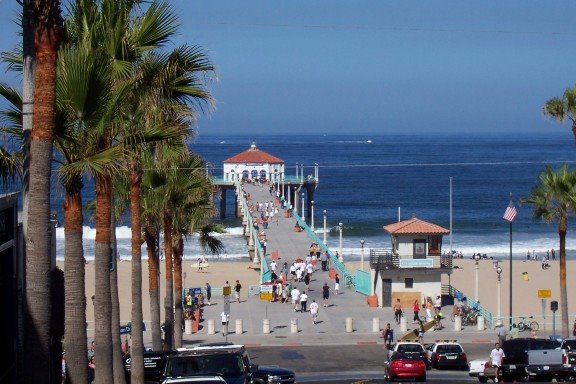
Bike Path... Manhattan Beach
The biggest disconnect between the asking price and the actual sale price for homes and townhomes is in Manhattan Beach and South Redondo. In Manhattan Beach the current median list price of a home is $1,899,000 while the median sold price is $1,200,000. In South Redondo the median list price is $1,350,000 and the sold price is $730,000.
There has been a number of articles in the media recently about how sticky the prices have remained in most of the upscale areas in all parts of the country. The general consensus is that prices may soon begin to fall in these areas as the economy continues to falter. In the last few days, with interest rates bouncing around like crazy, there is concern that the flurry of home sales activity in recent months will halt if rates suddenly move upward. I believe that is true.
Pending sales are defintiely up in all the Beach Cities as many sellers have begun to lower their asking price by some substantial amounts. New listings that are priced right are also selling quickly while older listings with high prices continue to remain on the market. I suspect that in the coming months you are going to see prices finally move downward on homes that have been on the market for a long time without finding a buyer. There are a number of properties that have been for sale for well over a year. If owners are serious about selling they will have to reduce the price to a point where potential buyers find value.
The market in North Redondo saw prices adjust in 2007. As prices adapted to the demands of the market rather early we are now seeing the segment of the market possibly reaching the bottom. Last fall you could buy a starter home in North Redondo in the TRW tract for $475,000- $550,000. Those deals are gone. Prices have increased from the lows of October - December. Interest rates have played a part but so have low prices.
South Bay-Beach Cities: Sold April 2009 (click on graph to enlarge)

South Bay-Beach Cities: Sold March 2009
South Bay-Beach Cities: Sold February 2009
South Bay-Beach Cities: Sold January 2009
South Bay-Beach Cities: Sold December 2008
South Bay-Beach Cities: Sold November 2008South Bay-Beach Cities: Sold October 2008
South Bay-Beach Cities: Sold September 2008
South Bay-Beach Cities: Sold August 2008
South Bay-Beach Cities: Sold July 2008
South Bay-Beach Cities: Sold June 2008
South Bay-Beach Cities: Sold May 2008
South Bay-Beach Cities: SOLD March 2008
South Bay-Beach Cities: Sold February 2008
South Bay-Beach Cities: Sold January 2008
South Bay-Beach Cities: Sold November 2007
South Bay-Beach Cities: October SOLD 2007
South Bay-Beach Cities: September SOLD 2007
South Bay-Beach Cities: August SOLD 2007
South Bay- Beach Cities: July Sold 2007
South Bay-Beach Cities: Sold June 2007
South Bay-Beach Cities: Sold May 2007
South Bay-Beach Cities: Sold April 2007
South Bay-Beach Cities: Sold March 2007
South Bay-Beach Cities: Sold February 2007
South Bay-Beach Cities: Sold January 2007





2 comments:
Love the color Kaye - thanks. You do a very good job of keeping your thoughts on the downturn objective, which in my opinion, isn't a quality most realtors have.
Quick question, which I already have a view on, is do you think this spring selling season is any better/worse than past springs. I don't have the inclination to go look at past year's sales, but it seems to me that this is the typical pattern. Doesn't inventory typically decline during the spring, albeit, usually at a faster clip. Some think RE is making a comeback in MB simply bc sales are being made. Sure, based on how sales went in the fall and early winter, it feels like there are lots of sales, but nothing special in comparison to past springs...
As for rates, while lower rates are always better for sales, I've been saying for some time that if jumbo rates go to 4% it won't spark a turn. Savings is still way to low, reversion to the mean in consumption as a percentage of GDP is underway (now at 70.5% and average between 1980-2000 was 67%), unemployment is rising, and the move up or even move sideways market is disturbingly low (great article on Mark Hansen's blog recently where organic sales are down 70%). Lower rates won't be the utopia that it has been in the past.
As always, the key to buying in a down market is to pay 2010 prices today, which will insulate the downward move in home values that we are sure to see between now and year end. Some deals seems to be getting done, but on average, I still think prices in MB will be moving 10-20% lower in the next 6-12 months.
Mookie,
I'll try and take your questions in order...
1. Historically spring is the best market.. summer is not too bad with sales typically slowing in August as people gear toward end of summer vacations and back to school.. then we occasionally see a small uptick in sales October- November.. then quiet until after Super Bowl Sunday the following year.
There is no question that sale volume is lower then in recent years but definitely up from the last 6 months. The homes that are selling are new listings that are either priced at or slightly below market and older listings that have finally found the right price after a number of price reductions. There are still homes that have been on the market for a very long time that buyers feel are priced above value and those homes will continue to remain on the market.
2. I think the lower rates and the availability of Jumbo loans have definitely brought buyers back into the market. However these buyers are very price conscious and have set specific limits on what they will spend... no matter how much they like a home. I have a number of clients who have been out of the market since 2006-2007 who have decided to take advantage of the lower rates and long term financing.
While overall state and national unemployment continues to rise, the Beach Cities have been holding at 6% (+/-) so many buyers may feel fairly confident that they will continue to be employed.
3. If the economists are right and the recession ends fairly soon, then I'm thinking maybe another 8%-10% from today's actual "sold" prices would not be out of the question. What may surprise you is that those who are buying today are taking that into account.
We have still not seen the large numbers of foreclosures that would move the market downward at a fast and steep pace. Until folks are forced to sell or lose their homes via foreclosure, most will hang on and not lower prices as much as will owners in markets that feel more distress.
That has always been the dilemma when trying to take the problems found in markets where owners have tighter financial reserve issues and make direct comparisons to the upscale end of the market where owners generally have more resources.
Upscale markets definitely lose value but it is often not as deep a loss and may not last a long as the problems in other ends of the market. This becomes more noticeable in places where most of the homes are either custom built or semi-custom built.
Upscale markets that have large developments often run into more trouble because a Plan III is a Plan III. If Joe sells his Plan III for $XXX.. then Mike probably isn't going to get thousands more for his same plan that is 2 doors down the street. We see that in Manhattan Village.
I believe we have a way to go before there is a sustainable uptick in the market. There will always be outstanding homes in the prime locations that will command some very high prices. Generaly I think the best we can hope for over the next few years is a relatively stable market with minimal movement in either direction.
P.S, Thanks for the kind words....
Post a Comment